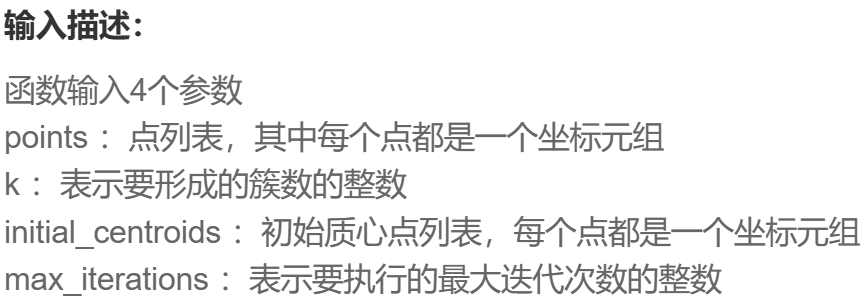牛客网 AI题(二)机器学习 + 深度学习
目录
机器学习 ML
ML 23 k-means
ML24 交叉验证数据拆分
ML25 主成分分析 (PCA)
ML26 k近邻算法
深度学习
NLP287624 最优字符串对齐距离
NLP287602 实现TF-IDF
DL23 位置编码计算器
机器学习 ML
ML 23 k-means


法一:直接调用 sklearn.cluster 的 k_means
import numpy as np
from sklearn.cluster import k_meansdef k_means_clustering(points, k, initial_centroids, max_iterations):# 中心点;标签;样本点到所属簇中心的距离平方和centroid, labels, inertia = k_means(points, k, init=np.array(initial_centroids), max_iter=max_iterations)ans = [] # 按题目要求,把结果点的坐标 原二维列表 -> 元组for p in centroid:p = p.round(4)ans.append(tuple(p))return ans法二:手搓
每行是 中心点位置,每列是 points;
每一列 points 根据欧式距离,分配到最小距离的那个中心点。
对每个簇 取均值算新中心点;检查和之前是否重合。
def k_means_clustering(points, k, initial_centroids, max_iterations):points = np.array(points)centroids = np.array(initial_centroids)for _ in range(max_iterations):# Assign points to the nearest centroiddistances = np.array([np.sqrt(((points - centroid) ** 2).sum(axis=1)) for centroid in centroids])assignments = np.argmin(distances, axis=0)new_centroids = np.array([points[assignments == i].mean(axis=0) if len(points[assignments == i]) > 0 else centroids[i] for i in range(k)])# Check for convergenceif np.all(centroids == new_centroids):breakcentroids = np.round(new_centroids, 4)return [tuple(centroid) for centroid in centroids] ML24 交叉验证数据拆分
k 折每一次的 i,第 i 折作为测试集,其余前后拼接起来作为训练集。
预处理 先把每个子块的开始位置和结束位置;最后把 np 转换为 list。
def cross_validation_split(data, k, seed=42):np.random.seed(seed)np.random.shuffle(data)n, m = data.shapesub_size = int(np.ceil(n / k))# 每一子区间的开始和结束索引id_s = np.arange(0, n, sub_size)id_e = id_s + sub_sizeif id_e[-1] > n:id_e[-1] = nreturn [[np.concatenate([data[:id_s[i]], data[id_e[i]:]], axis=0).tolist(), data[id_s[i]: id_e[i]].tolist()] for i in range(k)]ML25 主成分分析 (PCA)
对每列每个特征 标准化数据集,计算 X^T*X的协方差矩阵,
找到特征值和特征向量,返回主成分(与前 k 大特征值对应的特征向量)
def pca(data, k):data_standardized = (data - np.mean(data, axis=0)) / np.std(data, axis=0)covariance_matrix = np.cov(data_standardized, rowvar=False)eigenvalues, eigenvectors = np.linalg.eig(covariance_matrix)# 对特征值倒序索引以及对应向量idx = np.argsort(eigenvalues)[::-1]eigenvectors_sorted = eigenvectors[:,idx]principal_components = eigenvectors_sorted[:, :k]return np.round(principal_components, 4)调用 sklearn;
from sklearn.decomposition import PCA
from sklearn.preprocessing import StandardScalerdef pca(data, k):# 检查k值是否有效n_samples, n_features = data.shapek = min(k, n_features) # k不能超过特征数量# 1. 标准化数据scaler = StandardScaler()data_standardized = scaler.fit_transform(data)# 2. 创建PCA对象,指定主成分数量pca_ = PCA(n_components=k)# 3. 拟合数据pca_.fit(data_standardized)# 4. 获取主成分并调整格式components = pca_.components_.T # 转置,使每列是一个主成分return np.round(components, 4)ML26 k近邻算法
m行 m个样本,每个样本 n 个特征,一个标签。
找 test 的 k近邻,先求与每个样本距离差的二范数 axis = 1
-> 前 k 小的距离对应的索引和标签。
对得到的标签投片:均值 or 众数
def k_nearest_neighbors(X, y, test_sample, k):distances = np.linalg.norm(X - test_sample, axis=1)nearest_indices = np.argsort(distances)[:k]nearest_labels = y[nearest_indices]return int(np.round(np.mean(nearest_labels))) # 标签均值unique, counts = np.unique(nearest_labels, return_counts=True)return unique[np.argmax(counts)] # 深度学习
NLP287624 最优字符串对齐距离
允许的编辑操作(每个操作代价为1):
1. 插入一个字符
2. 删除一个字符
3. 替换一个字符
4. 交换相邻的两个字符 (比之前的编辑距离多了这个)
二维 dp 先初始化单边的 dp[0][i] = i
如果当前两个字母相同,一定就不改 dp[i-1][j-1]
否则 增删改 分别对应 (i-1,j) (i,j-1) (i-1,j-1)
交换两个字符,仅在 最后两个字符正好对应的倒序这个操作才有意义,额外判断。
def OSA(source: str, target: str) -> int:n, m = len(source), len(target)dp = [[0]*(m+1) for _ in range(n+1)]for i in range(m):dp[0][i] = ifor i in range(n):dp[i][0] = ifor i in range(1,n+1):for j in range(1,m+1):if source[i-1] == target[j-1]:dp[i][j] = dp[i-1][j-1]else:dp[i][j] = min(dp[i-1][j-1],dp[i][j-1],dp[i-1][j])+1if i>1 and j>1 and source[i-1] == target[j-2] and source[i-2] == target[j-1]:dp[i][j] = min(dp[i][j],dp[i-2][j-2]+1)return dp[-1][-1]NLP287602 实现TF-IDF
评估一个词对于文档集中的某个文档的重要程度。TF * IDF
TF = 词在文档中出现次数 / 文档总词数 IDF = log((文档总数 + 1) / (包含该词的文档数 + 1)) + 1
1. 建立词典和索引
2. 按每个文档 统计每个词的频率 -> TF
3. TF 的(每个词)列非零出现在多少文档 -> IDF
最终把 query 中词对应索引的那些列输出。
def compute_tf_idf(corpus, query):# 文档和问题的并集 -> 所有词的词表,建立索引到词的映射vocab = sorted(set(word for document in corpus for word in document).union(query))word_to_index = {word: idx for idx, word in enumerate(vocab)}# 文档 - 词tf = np.zeros((len(corpus), len(vocab)))for doc_idx, document in enumerate(corpus):for word in document:word_idx = word_to_index[word]tf[doc_idx, word_idx] += 1# 统计每个文档中 每个词的词频,再除以文档长度tf[doc_idx, :] /= len(document)# 每列(每个词)多少个文档中出现df = np.count_nonzero(tf > 0, axis=0)num_docs = len(corpus)idf = np.log((num_docs + 1) / (df + 1)) + 1tf_idf = tf * idf# 输出 query 对应列的情况query_indices = [word_to_index[word] for word in query]return np.round(tf_idf[:, query_indices], 5).tolist()DL23 位置编码计算器
PE(pos, 2i) = sin(pos / 10000^(2i/d_model)) # 偶数维度 PE(pos, 2i+1) = cos(pos / 10000^(2i/d_model)) # 奇数维度
位置为分子,维度为分母(变化快慢不一样)
就像 sin (w*pos) ,不同维度的系数 w 不一样。
每行pos,每列维度,计算角度矩阵。偶项正弦,奇项余弦,拼接转换为 float16.
def pos_encoding(position: int, d_model: int):# 检查if position == 0 or d_model <= 0:return np.array(-1)# 初始化位置 列向量 pos 和 行向量 indpos = np.array(np.arange(position), np.float32)ind = np.array(np.arange(d_model), np.float32)pos = pos.reshape(-1, 1)ind = ind.reshape(1, -1)# 计算角度angle1 = pos / np.power(10000, (2 * (ind // 2)) / np.float32(d_model))# 拼接正弦和余弦sine = np.sin(angle1[:, 0::2])cosine = np.cos(angle1[:, 1::2])pos_encoding = np.concatenate([sine, cosine], axis=-1)# 转换为16位浮点数return np.float16(pos_encoding)
